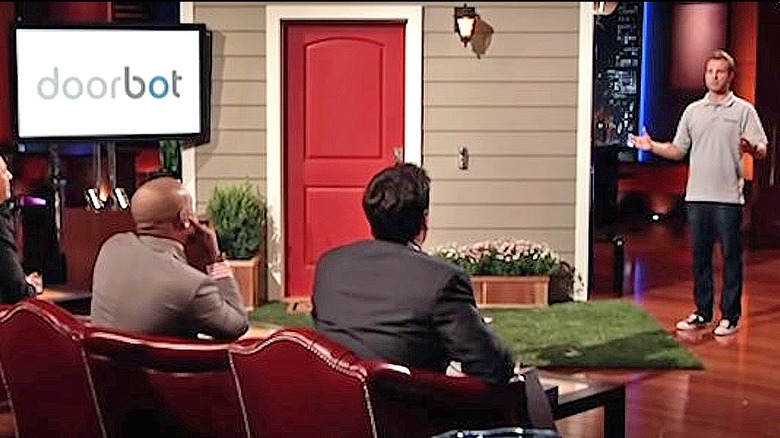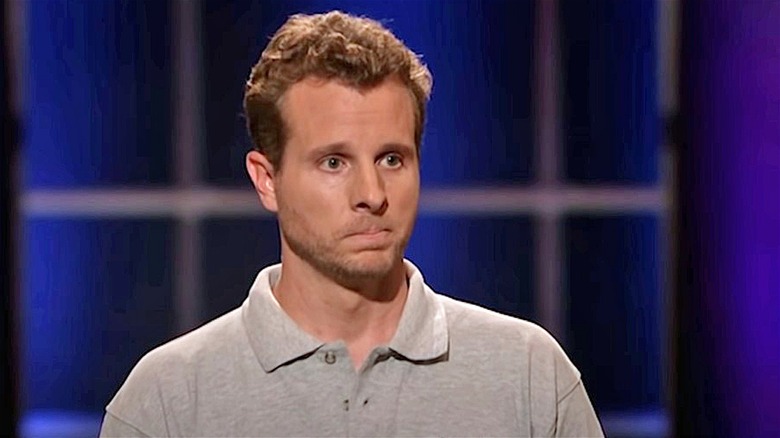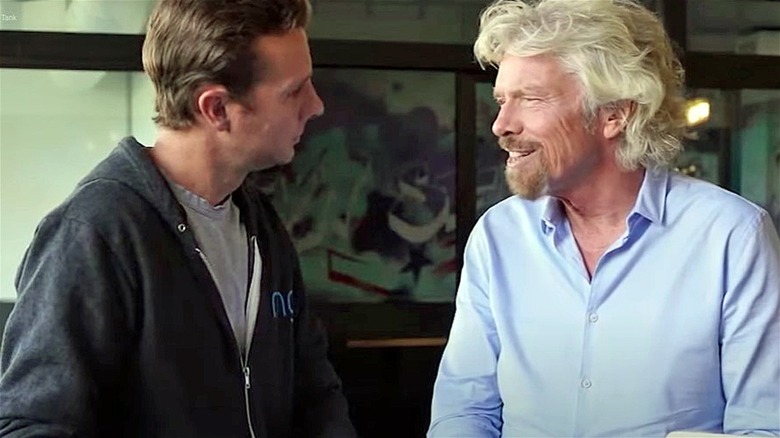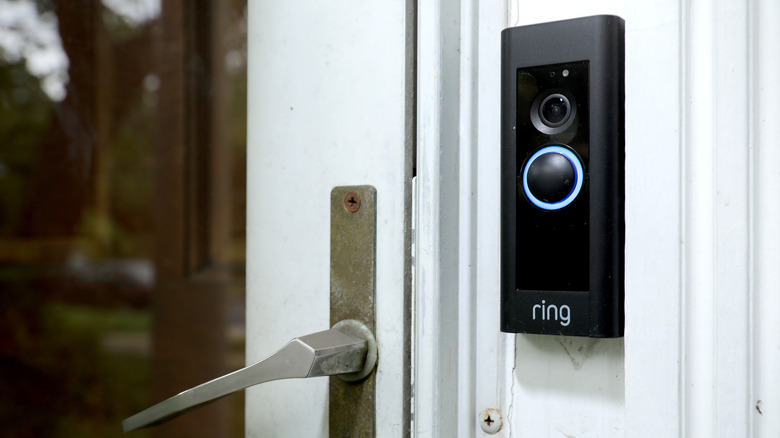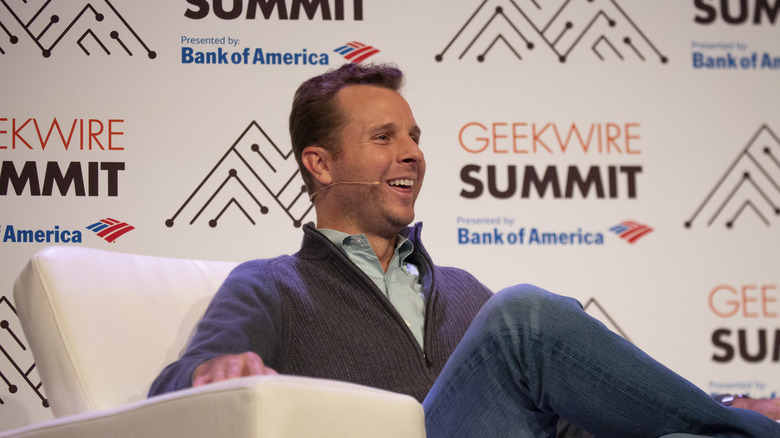Whatever Happened To Doorbot After Shark Tank Season 5?
As the CEO of Ring, Jamie Siminoff bears the distinction of having been unsuccessful in scoring a single deal with an investor on Shark Tank. When he first presented his idea to the Sharks for the world's first WiFi doorbell, called Doorbot, he held out hope that he would find a sponsor in Mark Cuban, Lori Greiner, Daymond John, Robert Herjavec, or Kevin O'Leary. Instead, Siminoff walked away without a single partnership. Dejected yet determined, he continued to develop his product and pursue his dream, and a few years later, he became the first contestant on Shark Tank to return as a guest Shark.
Long before he became the CEO of his billion-dollar company, however, Siminoff was the class clown in school, filled with energy and a lot of curiosity, per Digital Trends. He loved to know how things worked and to spend time in his garage building things. Using his skills and his drive to create something new after college, Siminoff created a company called PhoneTag, a text transcription service. He eventually sold the successful company for $17 million. This experience gave him the motivation to return to his garage and continue to experiment with ideas for the next great invention. It was while he was in his garage one day that he decided that he needed a better way to hear the doorbell. Putting his inventive skills to work, he created a basic WiFi device that notified his smartphone when someone was at his front door.
What happened to Doorbot on Shark Tank?
As he developed his invention, which he called Doorbot, Siminoff's wife agreed that it was worth pursuing. "When he started to talk about the doorbell, I thought, 'that's a good idea,'" Erin said. "That would definitely make me feel safer," per Digital Trends. After being invited to appear on Shark Tank in November 2013, Jamie presented Doorbot to the Sharks with the suggestion, "Think of it as Caller ID for your front door." He asked for $700,000 with a 10% stake in the company. The Sharks were intrigued and impressed with the sales volume that Doorbot had already achieved through online purchases. But they were curious about Doorbot's competition. Siminoff explained that other video devices existed, but none of them was connected to a smartphone. Lori Greiner was unconvinced that the Doorbot was distinct enough from the competition and declared herself out. Cuban explained that he would need to believe that the company could grow in value to $80 million or $90 million. "I just don't see that progression, and for that reason, I'm out," he said.
Daymond John and Robert Herjavec also expressed reservations about where Doorbot would be positioned in the market, and both declared themselves to be out as well. Kevin O'Leary, a.k.a. Mr. Wonderful, was the only Shark to make an offer to Siminoff, but he declined the royalty deal that O'Leary proposed.
Doorbot becomes Ring after Shark Tank
Siminoff says that the drive home after filming Shark Tank was terrible, according to GeekWire. He had spent close to $20,000 to build the set used for his presentation on the show, which was the last of the funds that Doorbot had in the bank. He says he returned to his garage to face his three employees, and he hated admitting that he hadn't made a single deal on the show. While the drive home may have been agonizing, as it turns out, the next month turned out to be very lucrative for Doorbot. It seems that appearing on Shark Tank was great for Siminoff's business, as he estimates that the airing gave him $5 million in additional sales. Siminoff saw the opportunity and redesigned Doorbot to expand its functionality, and he gave it a new name, Ring.
Ring became available on QVC, at one point making enough sales to earn $22.5 million in one 24-hour period. As Ring grew in popularity, it became more widespread in use. One day, it made an impression on entrepreneur Richard Branson. While visiting with a friend who had come to stay on his private island, Branson saw the remarkable way that Ring allowed his friend to interact with a delivery person at his home thousands of miles away. This single experience was enough to convince Branson to invest $28 million in Ring just a few days later.
Business is booming for Ring
Branson was not the only investor to partner together with Siminoff. The former NBA basketball player Shaquille O'Neal discovered Ring for himself one day and was impressed, per Digital Trends. "I just moved to a big house in Atlanta," O'Neal explained. "I called a big security company, and they tried to overcharge me. So I go to Best Buy, I see the Ring doorbell, I get it, and it works perfectly." He was so pleased with the product that he contacted Siminoff to suggest a partnership where he would become the new spokesperson for Ring. In the meantime, reports of Ring's success in keeping neighborhoods safe were beginning to become popular. In one example, Siminoff describes how a woman's Ring camera alerted her phone about activity outside her home, which turned out to be a house fire across the street. The residents of the home were evacuated safely, and Ring began to play a part in successful stories such as this one time and time again.
In 2018, Amazon purchased Ring for a deal that's estimated to be worth around $1 billion, with Siminoff remaining as CEO. It was an astounding development, and it confirms that Siminoff was right to stay committed to his product despite the apparent setbacks over the years.
What's next for Ring?
The $1 billion deal with Amazon contrasts with the skepticism that Siminoff encountered during his appearance on Shark Tank, and O'Leary has suggested that passing up the chance to invest in Ring was "probably the biggest miss" in the history of the show, per GeekWire. "When I saw the deal cross the tape last night, I said, ay, chihuahua, caramba," O'Leary said. Ring has become an integral part of neighborhood safety today, and its social media accounts are filled with videos submitted by customers, called "neighbors," demonstrating how Ring has helped them stay safe by remaining vigilant.
Looking back at how far he's come and what he's learned through this process, Siminoff explains how he kept going when things were difficult, and he wasn't sure how he was going to keep his business afloat. "Failure is not an endpoint," Siminoff says (per Inc.). "Every time I hit the bottom, that's when I learned the most to get to the top again." Thinking back to the days when he was trying to come up with the next great idea, Siminoff observes, "Your customers want to be part of a mission. Your team wants to be part of a mission. Your vendors want to be part of a mission," he says. Once he decided that his mission was to help neighbors feel safe, the rest of the journey was easy.
